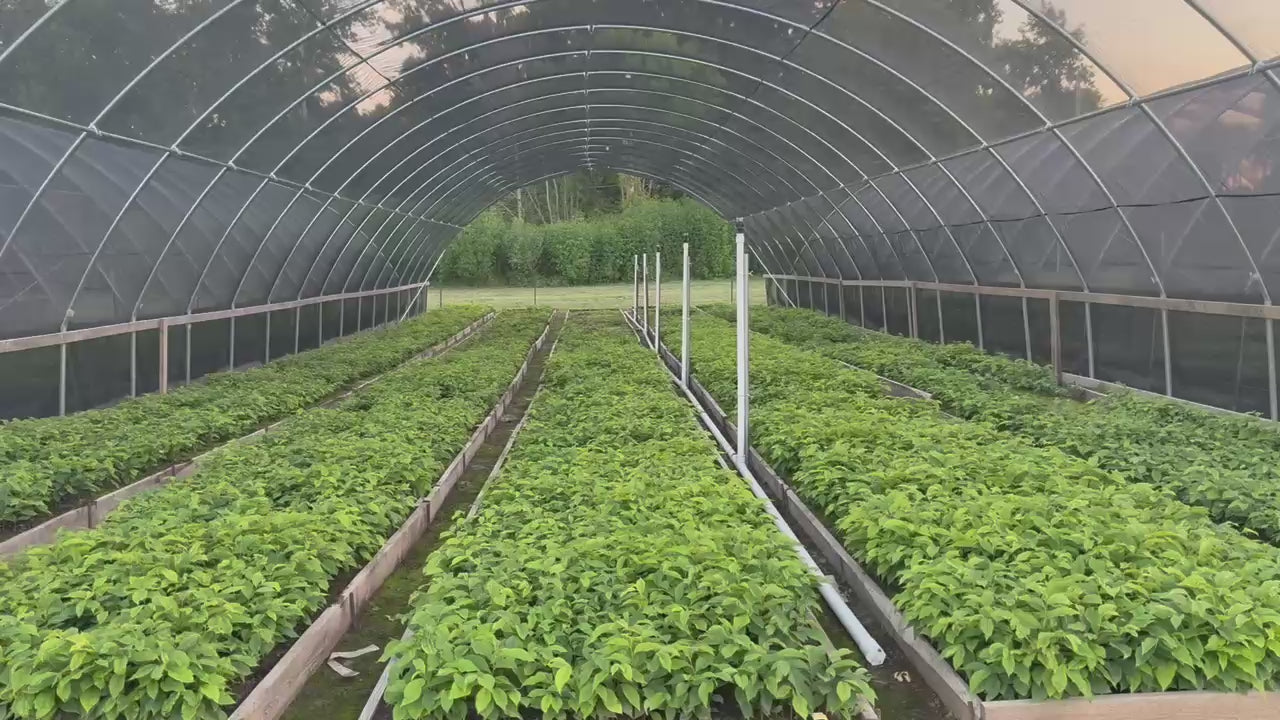Pawpaw Trees For Sale
The Paw paw tree is a flowering fruit tree native to the Eastern United States and Canada. It usually grows as an understory tree in temperate deciduous forests. The word comes from the Algonquian word papaya, meaning "enlarge," but it has also been suggested that it comes from pawpau, a name referring to the plant's resemblance to a monkey's paw.
At TN Nursery, our paw paw fruit trees come pre-pollinated. We grow them in production greenhouses, and we guarantee your trees will bear fruit once they mature. Don't worry about figuring it out; that's what we are here for.
TN Nursery grows over 2 tons of pawpaw seeds each year, and if our crop is effective, we will be producing an inventory of more than 4 million pawpaw trees. This makes us the largest pawpaw tree grower in the United States. Our commitment to native species like the pawpaw supports pollinators, biodiversity, and sustainable reforestation efforts nationwide.
Uses of Paw paw Trees in Your Yard
Native Americans used the fruits from this tree as food, drink, and for curing ailments. The fruit was eaten raw, and the juice was used to flavor foods and make a simple syrup. The fruit was also fermented into an alcoholic beverage. Today, the fermented fruit is popular in many parts of the United States and Canada as a soft drink known as "Paw Paw wine."
The seeds have been used to treat diarrhea in children. These trees are the source of a variety of pawpaw medicines. This shrub oil is used for arthritis and relieves joint pain, and the root bark is a source of an estrogen-like compound that may have contraceptive effects. Its leaves contain high omega-3 fatty acids and vitamins A, B, C, and D. The American Indians used this tree to treat skin and respiratory problems, rashes, heartburn, sore throats, and earaches.
Pawpaw Cultivation
The pawpaw is easy to grow in well-drained, moist soil or preferably in a deep, rich loam. It thrives in slightly acidic soil with a pH of 4.5 to 5.5 and can grow in full sun or partial shade, although it prefers dappled shade (light shade with some sunlight). It can also be grown as a container tree. Pawpaw trees are propagated from seed or by grafting onto dwarfing rootstocks.
About the paw paw Seeds
The seeds ripen between August and October, and the fruit forms around March in warm weather areas and later in cooler regions. The fruits mature from late September to January in cold and warmer areas from April to early July. The pawpaw tree is a diploid species with two sets of chromosomes: one chromosome set (n) and two chromosome sets (2n).
Pawpaw trees are propagated by planting seeds, but this takes several years before the seedlings can be grown. The trees are hardy in zones 4-10 and thrive in the coastal plain. Seeds germinate best where the soil temperature is between 60 and 75 degrees Fahrenheit. It is recommended that the seeds be sown at intervals of 2-3 weeks.
Frequently Asked Questions About Pawpaw Trees
What is a pawpaw tree?
The pawpaw tree, also known as Asimina triloba, is a native North American fruit tree characterized by its large, tropical-looking leaves and custard-like fruit that tastes like a blend of banana and mango.
What zones do pawpaw trees grow in?
Pawpaw trees do well in zones 5-9. They prefer temperate regions with colder winters and hotter summers to produce fruit to their fullest potential. Our pawpaws grow in the Tennessee region, and that climate is perfect for them.
Do you need more than one pawpaw tree for fruit?
Yes, but our trees are pre-pollinated. Pawpaw trees require cross-pollination from a different genetic tree to set fruit. You don't need to plant two or more trees; our trees are greenhouse-grown, and this is usually done for you.
How long does it take for a pawpaw tree to bear fruit?
Depending on growing conditions and care, they will start producing in 4 to 6 years after planting.
Where Should I plant my pawpaw trees?
Rich, moist, well-drained soil is in full sun to partial shade. Young trees benefit from some shade during the first couple of years.
How do you care for pawpaw trees?
The Pawpaw Tree thrives in moist soil. Mulch around the base to retain water and protect young trees from harsh sunlight. Pruning is rarely needed beyond removing dead or crossing branches. This is a high-demand, super-low-maintenance native tree that gives back.

Exposure
Partial sun/shade
Height at Maturity
Under 25 Feet
Usage
Fruit, wildlife,
Shipped As
Bare-root
Ships
UPS
Planting Zones
4-9





